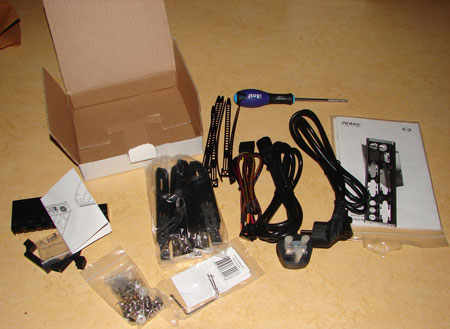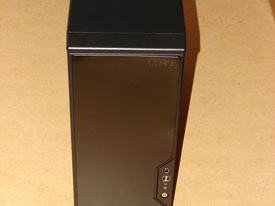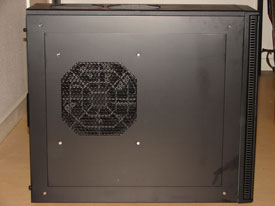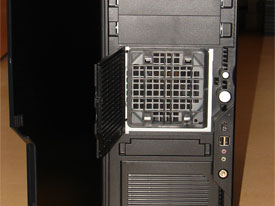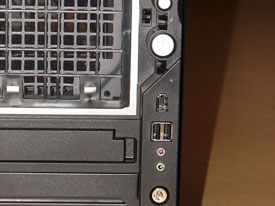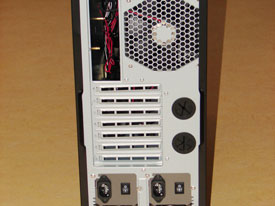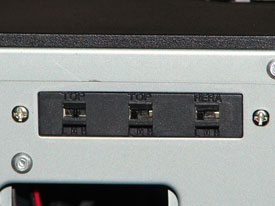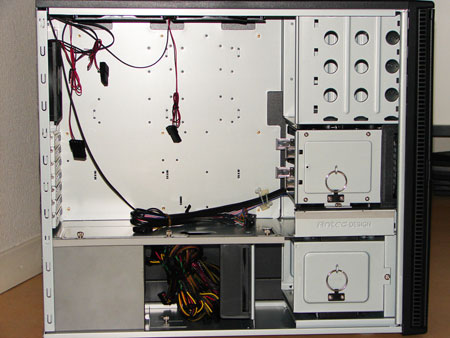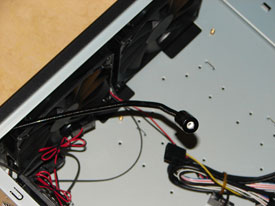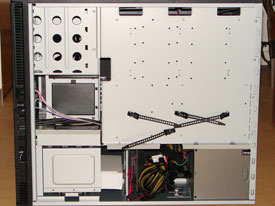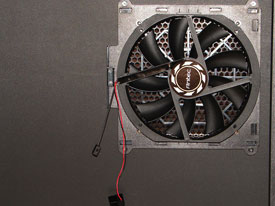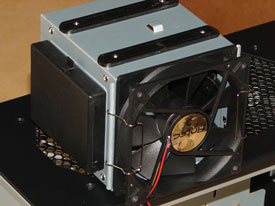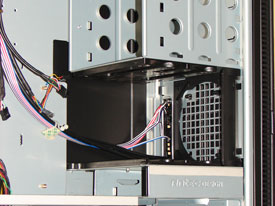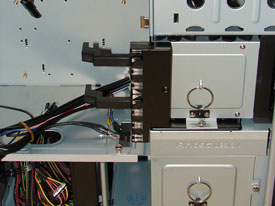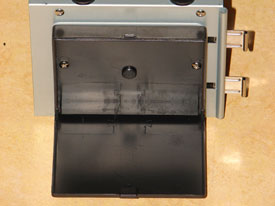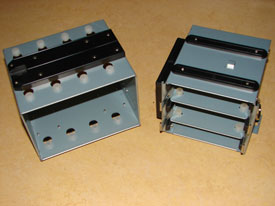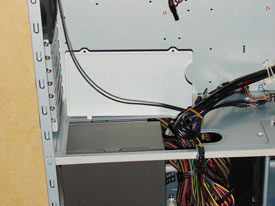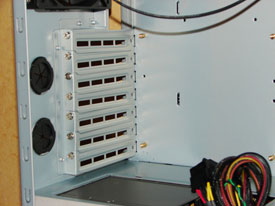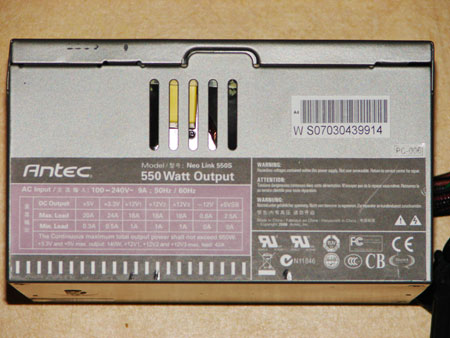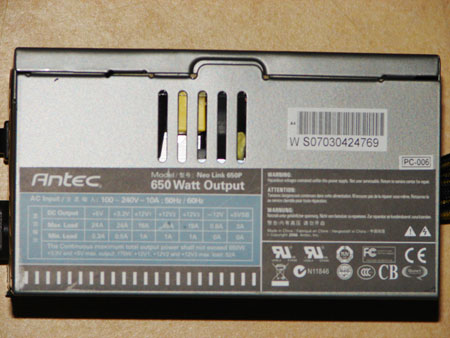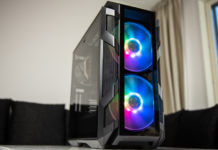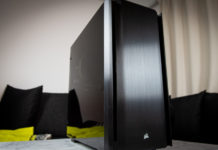Antec Performance One P190 is the biggest sibling of the Performance One family. It has many of the advantages of the smaller models, but more fans and space. In our latest review we investigate what the P190 has to offer.
Antec Performance One is probably the most praised series of cases of today. It all began with the P180, which was designed together with the expertise from the community of silent PC builders. P180 have gone through several minor updates, among other a new sturdier door, and later got a successor in the shape of P182, a case we reviewed earlier this year. Antec also launched a smaller case of the Performance One series that was also been showered with praise, the P150. It’s clean design and rubber suspension for the harddrives made it a real crowd pleaser.
Today we’re going to look at the latest addition to the Performance One series, the P190. As the name implies this is an even bigger model. While the P182 was mainly updated in the interior and kept the same outer measurements, the P190 is physically larger. It’s slightly higher, but above all longer than the previous mid-size models of the Performance One series.
Antec Performance One P190 is still a miditower, but both I and Antec would rather call it a Super Miditower, because it’s a very large and most of all heavy case. Antec has chosen to include two power supplies at 550 W and 650 W respectively, which adds quite a lot of kilos/pounds to the weight, but also more than a few dollars to the price. Twelvehundred watts never comes cheap.
On the following pages we will investigate whether the newest addition to the Performance One series can live up to the very good reputation of the previous models.
 |
|
|
Antec Performance One P190
|
|
| Case: | Miditower |
| Side panel: | 200 mm fan |
| Measurements (HxWxD): | 51.5cm x 20.5cm x 59.3cm 20.28″ x 8.07″ x 23.35″ |
| Weight: | 43.2 lbs / 19.6kg |
| Motherboard support : | mATX, ATX |
| Cooling (fans): | Rear – 120 mm Roof – 2 x 140 mm Lower chamber – 120 mm Side panel – 200 mm Front – 120 mm (not included) Upper harddrives – 120 mm (not included) |
| Material: | Side panels made from dual layer: plastic – aluminum Frame made from 0.8 mm stainless Japanese steel |
| Internal units: | 6×3,5” |
| External units: | 4×5.25” 1×3.5” |
| Expansion slots: | 7 |
| Power supply | Antec NeoLink 650P 650 W Antec NeoLink 550S 550 W |
| Other: | Detachable harddrive cages FireWire, USB, mic and headphone connectors in the front Compartment for storing screws, etc.. Two-chamber design Rubber dampening throughout the case Holes for routing water tubes through Tons of screws and extra brackets for the harddrives, optical units and fans. Removable and washable dust filters Cable ties Snake light Manual Support for long and heavy graphics cards |
| Price: | ~$320 |
In our review of the P182 we said that it was a miditower size Large, well this one is XL then. The supported motherboard formfactors are the same, actually everything is pretty much the same as the P182. The number of internal 3.5″ and 5.25″ are the exact same and the harddrive cages are identical to the last. But then again, why fix something that isn’t broken? The frame is sturdy and heavy. This is not a case that you accidentally move, or even with ease move around. Where you put it, it stands.
The fan setup has changed quite a lot though. Antec Performance One P190 has two 140 mm fans in the roof, instead of one 120 mm. In the rear we still have a single 120 mm fan. The side of the P190 has a completely new design as Antec has chosen to fit it with a large 200 mm fan. All fans are of the TriCool series, meaning they have three different settings; High, Medium and Low. We still recommend the Low setting, not because the rest is painfully loud, but because the Low setting is enough to move a decent amount of air and any higher settings will not result in significantly lower temperatures. Below are the specifications of the three fans used in this case;
|
Antec TriCool 120 mm
|
|||
|
RPM
|
Airflow (CFM)
|
Noise (dB(A))
|
Power (W)
|
|
2000
|
79
|
30
|
2.9
|
|
1600
|
56
|
28
|
2.4
|
|
1200
|
39
|
25
|
1.6
|
|
Antec TriCool 140 mm
|
|||
|
RPM
|
Airflow (CFM)
|
Noise (dB(A))
|
Power (W)
|
|
1500
|
94.6
|
31.8
|
3.36
|
|
1100
|
66.8
|
21.4
|
2.4
|
|
700
|
47
|
19.8
|
1.8
|
|
Antec Big Boy 200 mm
|
|||
|
RPM
|
Airflow (CFM)
|
Noise (dB(A))
|
Power (W)
|
|
800
|
134.11
|
29.4
|
3.6
|
|
600
|
108.493
|
26.5
|
2.04
|
|
400
|
82.612
|
23.6
|
0.96
|
The side panels are a lot thinner with the P190 than of the P182. This is not a good thing in our opinion. The P182 was superb when it came to hindering noise from escaping. The P190 isn’t able to do the same. It has a lot more holes and the 200 mm fan especially let a lot of sounds through, relative to the P182. The 200 mm fan has its own dust filter which can easily be removed and washed.
|
Accessories, except the screwdriver of course
|
The accessories are as always plentiful. Cable ties are already attached to the back side of the motherboard plate and keeping the cables in order when the case arrives, you get an additional bunch if those aren’t enough. The manual contains just the right amount of information. Everything you need to know about how to install the various components of a computer. Also pin diagrams for the USB and IEEE 1394 connectors.
The Performance One P190 is clean and not a case you would be ashamed of it was visible beneath, or on top of, your desk. Maybe not a case you would show off to you friends in the middle of a party, but it looks good enough. The front has a black, polished surface that has some minor reflective properties while the sides are more of a dull black.
The good thing about P190, and the Performance One series as a whole, is that nothing really stands out and tries to be some sort of an attention grabber. The case feels whole and all of the parts blend. The sum of the parts are greater than their individual properties put together.
If you happen to see any dents in the front door, just ignore them (UPS has issues it needs to work out). Other than that the door is pretty much the same as on the P18X. When we open the door things are still very familiar. Not much have changed since our last acquaintance with the Performance One series, but don’t get me wrong, this is a good thing.
On there rear, things have changed slightly. All of the things we liked about the P182 are still here, but since this one has two power supplies and more fans, it looks a bit different. The power supplies are stacked on their sides so that both can be housed in the lower chamber of the case. This could certainly seem like a possible heat trap, but there is a decent airflow through them and the whole lower chamber, so nothing to worry about really.
At the top we find the controls for the fans, but with an additional one since it has two fans in the roof of the case instead of just one. They are well marked and have the same three settings; Low, Medium, High. There is a slight spelling error though …
The holes for water cooling tubes are still there along with the “new” expansion slot brackets with air holes. These are still being discussed and we know for a fact that people have been taping them shut or simply switching to brackets without holes to get a better airflow through the case.
The dual power supplies are lined up at the bottom. You don’t have to use both of them if you don’t want to and to be completely frank, most people doesn’t need both.
The case is divided into two chambers where the lower houses the power supplies and one harddrive cage. They are cooled by an Antec TriCool 120 mm fan in the middle. The upper chamber of the P190 is a lot roomier than the P182. The added length makes it a lot more pleasant to work inside. The only(?) bad thing about the P18X models is that they are a bit too narrow. The P190 offers more space and if you’re using a setup with two graphics cards you should really consider the P190 instead of the P18X models.
The overall layout of the interior is very familiar and there’s really not much to add that we haven’t already said about the P182. All of the fans are powered by regular 4-pin molex connectors, and the USB and firewire connectors on the front use the standardized head connectors that you connect to the USB and firewire pins on the motherboard. The pin layouts of these are specified in the manual if you want to be certain and compare them to the pin layouts on the motherboard.
Just like the P182 Special Edition, the P190 has a snake light. Although, the snake light of the P190 has a slightly thinner and stiffer arm than the P182 SE. I personally prefer the P182 model, but then again it’s not that often you actually use it. If we remove the right side cover we see a couple of cable ties that has been pre-installed. These are reusable and can be loosened and tightened an infinite number of times (in theory). The three holes at the top, the one on the left let you draw the power cables on the back of the motherboard plate to reduce obstructions of the air flow.
On the other side of the case there’s the Antec Big Boy 200 mm fan. This huge piece of cooling is actually fairly quiet and still capable of moving more than plenty of air. The power comes from a 4-pin molex connector and has a rpm controller with the same three settings as the other TriCool fans.
In the upper right picture you can see the upper harddrive cage remove and placed on top the case. We’ve used the brackets that comes with the case to attach a 120 mm fan to the cage. This will create a wind tunnel effect which helps for cooling the graphics card(s).
In the upper left picture you see the upper harddrive cage removed from the case, while on the upper right picture we have attached the mounting and support mechanism for long and heavy graphics cards. These can be placed in a variety of heights depending on your motherboard. This is pretty much the only time the manual is short on information as the installation isn’t explained very thoroughly.
Here we see the two harddrive bays and the small box for screws and other things that’s seated on the back of the upper harddrive bay. They have the same rubber dampenings as we’ve seen with the P18X models.
On the left you can see how we’ve opened up the lower chamber and unveiled the power supplies. They’re not very hard to remove from the case, but there’s really no reason for why you would want to do that. Twelve hundred watts is more than enough for any computer. The right picture shows the rear brackets and the holes for routing the water cooling tubes through if you use an external radiator.
The Antec Performance One P190 is shipped with two big and heavy power supplies. The Neo Power 650W is connected to a Neo Power PSU rated at 550 W through Antec NeoLink technology. There is a special connector with each power supply that makes the Neo Power 650P start up the Neo Power 550S. The whole idea is to have the 650 W PSU power your motherboard, processor, graphics cards and other add-in cards, and have the 550 W PSU supply your storage devices and peripheral hardware with juice.
We did a quick check on the UL file code and all of the 1200 W are made by Antec. No rebranding here.
|
Antec Neo Link 650P 650 W
|
|||||||
| Voltage |
+5V
|
+3.3V
|
+12V1
|
+12V2
|
+12V3
|
-12V
|
+5VSB
|
| Max.Load |
24A
|
24A
|
19A
|
19A
|
19A
|
0.8A
|
3A
|
| Min. Load |
0.3A
|
0.5A
|
1A
|
1A
|
1A
|
0A
|
0A
|
| Regulation |
±3%
|
±3%
|
±3%
|
±3%
|
±3%
|
±6%
|
±3%
|
| Ripple (mV) |
50
|
50
|
120
|
120
|
120
|
120
|
50
|
|
Antec Neo Link 550S 550 W
|
|||||||
| Voltage |
+5V
|
+3.3V
|
+12V1
|
+12V2
|
+12V3
|
-12V
|
+5VSB
|
| Max.Load |
20A
|
24A
|
18A
|
18A
|
18A
|
0.8A
|
3A
|
| Min. Load |
0.3A
|
0.5A
|
1A
|
1A
|
1A
|
0A
|
0A
|
| Regulation |
±3%
|
±3%
|
±3%
|
±3%
|
±3%
|
±6%
|
±3%
|
| Ripple (mV) |
50
|
50
|
120
|
120
|
120
|
120
|
50
|
We did some quick load tests, but found nothing out of the ordinary. The voltages were all within the ATX specifications during load and we have to say that they are fairly quiet.
So here we are. Another model of the Performance One series has been dissected and we have to say that we really liked this one too. First of all, the P190 feels huge in comparison to the P18X models. The box it comes in is a lot bigger and case itself gives an impression of being quite big at a first glance, but it’s really not. If we compare the measurements to some of Thermaltake’s and Cooler Master’s bigger cases like the Armor and the Stacker, the P190 is actually quite petite. It’s only longer than the P18X, but of course also has some other tweaks.
The cooling is quite different with more and bigger fans. The most obvious being the Antec Big Boy 200 mm fan seated on the side of the case. The fans in the roof of the case are now two and 140 mm in diameter. They are all fairly quiet and efficient. The RPM control on the back of the case is of course a big plus. The spelling error is also quite amusing the first few times. Overall there is a great airflow through the case and great potential for building a quiet and cool case.
The overall layout of the case is the exact same as with the older and smaller P18X models. Two chambers with the power supplies and one harddrive bay in the lower chamber, and the motherboard, 5.25″ devices and the second harddrive cage in the upper chamber. The bonus features that were added to the P182, that the P180 lacks, are all available with the P190, including the snake light. Rubber dampenings are everywhere to reduce vibrations and keep the noise at a minimum.
The 1200 watts are stable to the normal extent and way, way more than anyone will ever need. But they also pose a problem, because 1200 watts ain’t cheap. The lowest I can find the P190 for today is just below $300, and that’s a lot of money for a case, even though it has two bundled power supplies. To be completely frank, it’s just too much. Even for a really good case like this one.
Overall the Antec Performance One P190 is a truly great case and we can really recommend it, if you can afford it. Otherwise you can always take a look at the P180 or P182 models from Antec. They are very similar and much cheaper.
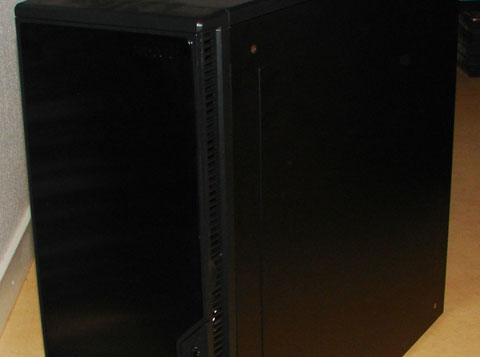 |
|
Antec Performance One P190
|
|
Pros Cons |
A huge thanks to Sofia Gubert at Lewis PR (Antec) for sending over the case.












